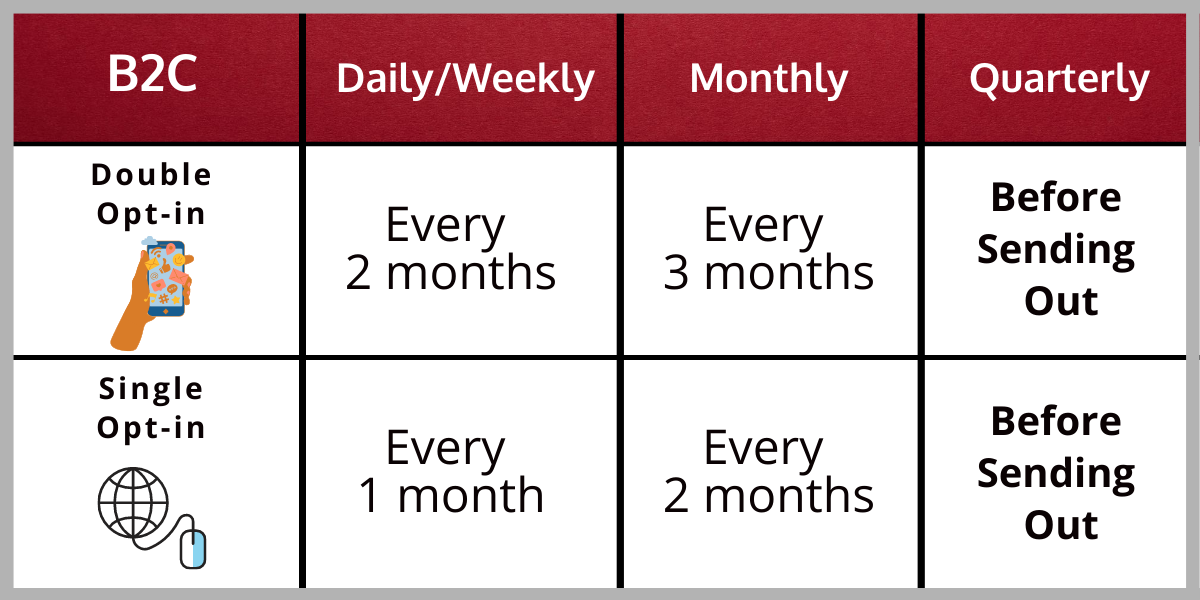5 Useful Tips To Strengthen Your Email List Cleaning Service
Creating an email marketing list is a crucial component of a successful campaign. Furthermore, it’s crucial to supplement those efforts with regular use of an email list cleaning service.
Email list cleaning, also known as scrubbing, involves removing inactive, bounced, and other non-engaging email addresses from your mailing list. Using a clean mailing list will allow you to:
- Improve your reputation as a sender
- Increase your engagement rates
- Reducing the chances of landing on a blacklist
For more information on how and when to clean your email list, read these five tips.
1. Decide how often your list needs to be cleaned up
You will need to decide how frequently you will scrub your email list depending on your campaign.
For most email campaigns, we recommend every six months. The larger your email list, the more frequently you should clean it, while smaller ones might not need as much attention.
As you look at your engagement metrics after each send, you will gather an overall picture of the health of your list and how often you should clean it.
Stick to your routine no matter what frequency you decide is best. If necessary, you may need to adjust your frequency of cleaning each year.
Also, don’t purchase lists from third parties, or anybody for that matter. Although you may be able to reap some immediate, short-term benefits from the list file, the majority of it will not be of much use. As a result, you may even be put on a blacklist.
Because of the list’s structure, users are more likely to click the spam button first. Both outcomes will negatively affect your email program.
2. Delete role accounts
Accounts representing groups or aliases are called role accounts – for example, @support, @info, etc. Since these emails don’t represent individuals, they aren’t checked or read often. Once the original employee who uses that email alias decides to resign, whoever steps into that role may mark your email as spam because they didn’t opt to receive it.
3. Remove all bounced or invalid emails
It is a good thing that most systems automatically remove hard bounces after two attempts. If you continually send emails to invalid addresses, your metrics can be adversely affected, particularly your delivery rates.
However, it can sometimes be difficult to identify invalid emails. You can utilize Verify550’s Email Validation API in cases of suspected bounced emails, which will show you which emails may become hard bounces. This will allow you to monitor them and maybe even get rid of them in the future.
4. Delete inactive recipients
Removing unengaged recipients can be particularly painful. Imagine how many emails you signed up for but never opened or read!
Although you must provide an unsubscribe link in your emails (by law and by all reputable email service providers), sometimes people don’t unsubscribe. It’s time to unsubscribe the recipient if a few months go by without the recipient opening your emails.
The engagement metrics of ISPs, such as Gmail and Yahoo, play a crucial role in determining delivery. It would be best if you didn’t give ISPs yet another reason not to inbox your messages.
5. Verify your email subscriptions
When you sign up, there are several ways to confirm your email address. It is best to provide a double opt-in method to ensure that the subscriber is interested in receiving emails.
During double opt-in signup, subscribers need to enter their emails on the signup form, followed by another confirmation.
Although double opt-in requires a little more effort on the user’s part, it is worth it for both the sender and the recipient because it automatically eliminates bad email addresses from your list.
Takeaways
Since 15% of email is not delivered, you want to ensure that you follow the best practices–including email list scrubbing–that will ensure you get into the inbox. You will be able to improve your email engagement, sender reputation, and delivery rates by regularly cleaning your email list.


